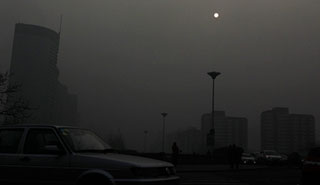China will make history this year when it surpasses the US as the world’s biggest economy, re-taking the crown it lost back in 1890, says The Economist.
As you know, China’s spectacular growth has serious negative consequences, both for the world’s atmosphere and its local environment – polluted soil, waterways and air, and habitat destruction. Its outsized greenhouse gas footprint is the primary reason the world can’t stabilize emissions and aerosols from air pollution enter the Pacific air stream, creating more intense storms in the US and elsewhere. Researchers at NASA’s Jet Propulsion Lab say it can easily be seen on satellite images.
China’s Premier Declares War on Pollution
For now, the focus is on China’s infamously polluted cities. Citizens have had enough and in response to their outcries, in March, Premier Li Keqiang said, "We will resolutely declare war against pollution as we declared war against poverty."

After decades of growth-at-all-costs, China will prioritize the environment over the economy, by revising its Environmental Protection law. Legislation passed last month gives the Ministry of Environmental Protection much more authority: it can reject new projects when major companies don’t cut emissions; dole out big, daily fines for violating laws; demote or fire local officials that shield polluters; and companies must provide real-time data on emissions or be subject to criminal penalties.
$1.65 billion has been set aside to reward clean companies, and $330 billion to tackle water and soil pollution. 300 polluting manufacturing plants will be shuddered this year and banks are barred from financing polluters. Three million polluting vehicles are being removed from service and fuel taxes and congesting pricing are likely.
China’s commitment to solar and wind has been strengthened and its national cap-and-trade program is advancing.
The goal is for 60% of cities to meet national pollution standards (three do now) by 2020.
Coal to Gas
One solution is causing more problems than it solves, however – building power plants far from cities in places like Inner Mongolia, where coal is converted into methane and then shipped to cities via pipelines.
City air may get cleaner, but producing, transporting and combusting the gas causes carbon emissions 82% higher than plain vanilla coal plants, reports Seattle Times. If all 18 planned plants get built, China’s annual emissions could be 7% higher.
These plants are huge. The one in Inner Mongolia takes up 400 square miles! It can supply 40% of Beijing’s needs at a cost of $4 billion to build.
And the government is also building coal refineries to produce chemicals in these rural areas, transferring air pollution to far-flung places like Mongolia, where people are being driven from traditional grazing lands as it turns into an industrial zone.
While China’s coal industry strongly supports the move to coal-gas plants, others say it isn’t a done deal. "A lot of people in the (Chinese) policy community oppose this," William Chandler, research director at the US-based Energy Transition Research Institute, told Seattle Times.
About a third of China’s pollution can be traced to the products it makes and ships to the US and Europe. Trade agreements from the early 1990s encouraged US companies to move there, exploiting cheap labor and lack of environmental standards.
"We made a big mistake by not including environmental safeguards in trade policies with China, said Mickey Kantor, chief trade negotiator under President Clinton.
Read more:
